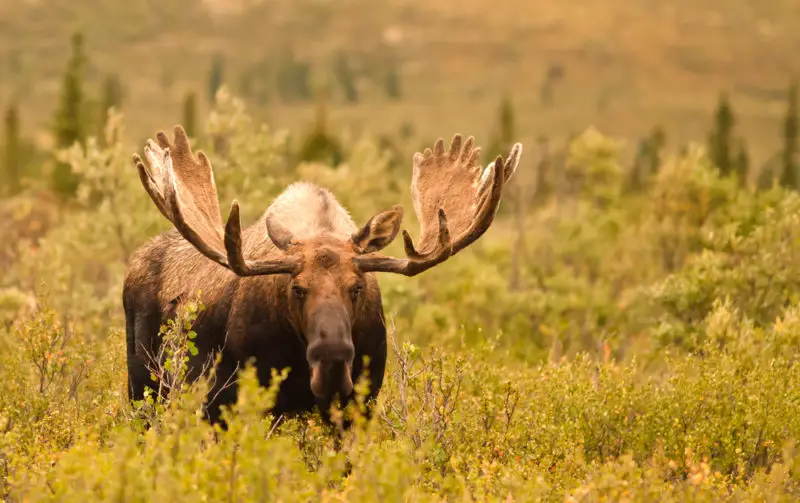Moose: The Unlikely Killers – An Insight into Their Deadliness

When we think of deadly animals, sharks often come to mind as the apex predators of the ocean. However, you might be surprised to learn that moose, the gentle giants of the forests, pose a greater threat to humans than sharks do. While shark attacks make headlines and fuel our fears, the statistics reveal a different story. In this article, we will explore the surprising reality that moose are responsible for more human fatalities than sharks. Let’s delve into the reasons behind this unexpected phenomenon and understand how to stay safe in moose territory.
The Unseen Danger: Moose Attacks
While it’s true that shark attacks instill fear and anxiety among beachgoers, moose attacks remain a largely underestimated danger. Moose are territorial animals, and during their breeding season, known as the rut, they can become highly aggressive. Bull moose can weigh up to 1500 pounds and possess sharp antlers, capable of inflicting fatal injuries on both humans and other animals. Moose are particularly dangerous when they feel threatened or cornered, and encounters with humans can quickly turn tragic.
Moose Habitat and Human Interaction
One of the main reasons why moose attacks surpass shark attacks is the proximity of their habitat to human settlements. Moose are commonly found in boreal forests, wetlands, and shrublands, which are often close to residential areas, hiking trails, and camping sites. While sharks mostly inhabit the ocean, reducing the likelihood of human encounters, moose often wander into human territories in search of food and water. This frequent overlap increases the chances of unfortunate confrontations.
Unpredictability of Moose Behavior
Unlike sharks, which generally display consistent patterns of behavior, moose can be unpredictable. While shark attacks are often attributed to curiosity or mistaken identity, moose attacks are frequently a result of the animal feeling threatened. Surprising a moose or getting between a cow and her calf can trigger an aggressive response. Additionally, wounded or sick moose can act erratically, posing a significant risk to anyone in their vicinity.
Driving Accidents Involving Moose
Moose-related fatalities aren’t limited to direct attacks. Collisions with vehicles are another leading cause of deaths involving moose. In regions where moose are prevalent, such as Canada and parts of the northern United States, these large animals can wander onto highways and roads, especially during dawn and dusk when visibility is reduced. Colliding with a moose can lead to severe injuries and fatalities for both drivers and passengers, highlighting another reason why moose prove deadlier than sharks.
Understanding Shark Attacks
Contrasting moose attacks, shark attacks are rarer and often misunderstood. Sharks primarily feed on marine animals and rarely target humans as prey. Most reported shark encounters are instances of mistaken identity or curiosity, with the shark quickly realizing that humans are not their natural food source. However, due to their intimidating appearance and portrayal in popular media, sharks have gained a reputation as ruthless killers, which doesn’t align with reality.
Staying Safe in Moose Territory
While the threat of moose attacks shouldn’t deter people from enjoying the great outdoors, it is essential to take precautions when venturing into moose territory:
- Stay Vigilant: Be alert and keep an eye out for any signs of moose presence, such as tracks or droppings. If you spot a moose nearby, give it plenty of space and avoid approaching it.
- Keep Dogs Leashed: Unleashed dogs can provoke moose and trigger aggressive behavior. Always keep your furry friends on a leash during hikes.
- Avoid the Rut Season: During the moose rut season, typically in late summer or early fall, their aggression peaks. If possible, plan outdoor activities in moose territory during other times of the year.
- Slow Down on Roads: When driving in areas known for moose crossings, reduce your speed and stay alert. Be particularly cautious during dawn and dusk.
Conclusion
While sharks have long been sensationalized as deadly predators, the reality is that moose pose a more significant threat to human safety. The overlapping habitats between moose and humans, coupled with the animals’ unpredictability, contribute to the higher number of moose-related fatalities. Understanding the behaviors of both moose and sharks is crucial for fostering coexistence and ensuring safety in their respective territories. By respecting moose habitats, staying vigilant, and taking necessary precautions, we can reduce the risk of moose encounters and appreciate these magnificent creatures from a safe distance.






